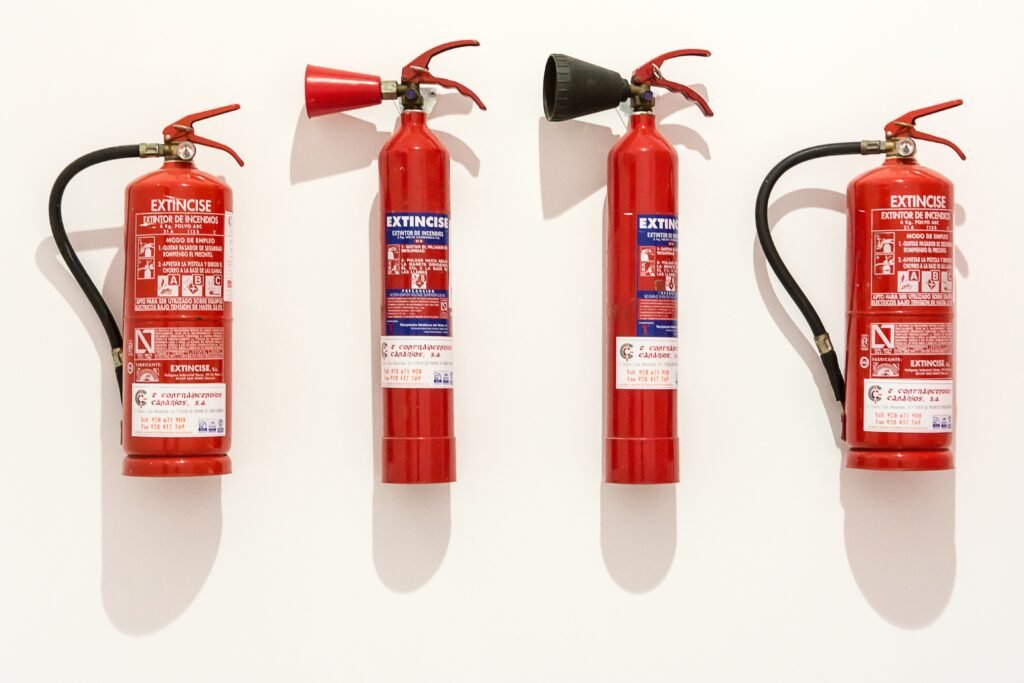How to Use a Fire Extinguisher Correctly?
A fire extinguisher is used in emergencies to extinguish or control small fires. It is not suitable for use on an out-of-control fire. It consists of a hand-held cylindrical pressure container having an agent used to extinguish a fire. The acronym for putting out a fire with a termination uses the PASS strategy: Pull the pin, Aim the hose, Squeeze the lever, and Sweep the hose. Let’s learn the types of fire extinguishers, when, and how to use them.

Types of fire extinguishers
Before proceeding to put out the fire, know the fire fuel and the correct type of fire extinguisher.
Class A
They are used for cloth, wood, rubber, and common combustible fires. The extinguishing agent is water or foam.
Class B
They are used for gasoline, grease, and oil fires, and the extinguishing agent is a dry chemical or carbon dioxide.
Class C
They are used for fires that involve sensitive equipment such as computers, servers, data centres, or other electrical equipment, electrical fires. The extinguishing agent is a dry chemical or carbon dioxide.
Class D
They are dry powdered extinguishers used for fires from combustible metals, such as magnesium, titanium, and sodium.
Class K
They offer improved fire control for cooking fires by forming a soapy foam on the surface of the hot cooking oil, holding in the vapours and steam, and smothering the fire. The extinguishing agent is a wet or dry chemical.
Class ABC
An ABC or Multi-Purpose Dry Chemical portable fire extinguisher is useful for Class A, B, and C fires. Every home and business should have at least one Class ABC fire extinguisher on each level. However, it is essential to know that Class ABC fire extinguishers are unsuitable for commercial kitchens.
How to properly use a fire extinguisher?
Once you understand the different types of fire extinguishers and their uses, you need to be able to operate one properly.
Get everybody safely out first.
Do not attempt to put out a fire alone using a fire extinguisher unless you know that everyone else has safely left the building.
Identify a clear escape route.
Before operating the fire extinguisher, ensure a clear exit track. You’ll need to make a safe exit if you cannot put out the fire.
Stand back
Face the fire and keep your back to the clear exit you earlier identified. It would help if you stayed between six and eight feet away from the flames as you prepare to use the fire extinguisher.
Now move toward how to use a fire extinguisher correctly.
Employ the PASS strategy to use a fire extinguisher properly.
Four simple steps for using modern portable fire extinguishers.
1) Pull the pin.
The fire extinguisher has a pin inserted into the handle to prevent them from being accidentally discharged. Hold the ring and pull out the plug from the side of the handle. The extinguisher is now ready to erupt. Hold the device with the nozzle facing away from you.
2) Aim the hose
Grab the lower grip lever with one hand and the hose or nozzle with the other. Do not point the hose at the flame. Aim the hose directly at the source of the fire because you must extinguish the burning fuel.
3) Squeeze the lever.
To release the extinguishing agent, apply slow and even pressures to squeeze the two levers together with one hand while you aim the hose at the base of the fire with the other hand. To stop discharging the extinguisher, release the levers.
4) Sweep the hose
To extinguish all the fuel, slowly sweep the hose back and forth over the base of the fire as you discharge the extinguisher. Move closer to the fire as the flames die down. Continue releasing until the fire goes out.
Tips you must follow to use fire extinguishers correctly.
Leave if you are unable to extinguish the fire
The average extinguisher is loaded with agents that go for about 10 seconds. Watch the fire closely to confirm the flames don’t spread again, and if pets are still there, you are better off leaving immediately.
Leave if the flames are taller
Fire extinguishers are meant to fight a fire if the flames are shorter than you. Evacuate immediately if the flames of fire are taller than you and are spreading and growing.
Evacuate a room filled with smoke.
Never try to combat a fire if the room is full of smoke. It’s best to cover your mouth and lie down to avoid smoke and creep out of the room. Inhaling the smoke can lead to unconsciousness, and you will be trapped in a room with flames.
Call the fire department if the situation is not under your control.
If flames are taller or the room is full of smoke and the fire is still spreading, instantly call emergency numbers.

Never leave an empty fire extinguisher at home or the office.
- Do not leave an empty fire extinguisher around because somebody may try to use it in an emergency.
- If an empty fire extinguisher is disposable, discard it right away.
- If your extinguisher is rechargeable, don’t put it off. Always keep it charged.
Read the instructions written in the user manual carefully.
It’s essential to review the user manual instructions about how to use a fire extinguisher correctly.
Replace the expired fire extinguishers with new ones
After the expiration date, the fire extinguishers are useless. So make sure to replace them regularly.
Instruct everyone about fire extinguisher usage
Everyone at home or working should know the fire extinguisher’s location and how to use it correctly.
Takeaway
A fire extinguisher is a life-saving device if used correctly and on time. So to keep everyone safe at home or office, thoroughly instruct them on how to use the fire extinguisher correctly.
If you like this article about fire extinguishers, please let me know in the comment section.
